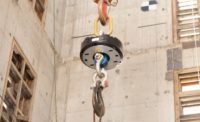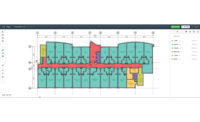Automating different elements of the design process is nothing new, but technology startup Hypar is taking it a few steps further.
With a cloud-based web app for generating designs based on preset parameters, Hypar seeks to skip the tedious design work of placing and tagging the building systems and elements found in a traditional BIM workflow. And with a recent $5.5-million Series A investment from construction venture capital firm Brick & Mortar Ventures and Building Venturesnow in hand, the company seeks to accelerate development of its new workflow.
“People see Hypar running and say ‘where’s the Revit in here.’ But Hypar is built from the ground up to be standalone,” explains Ian Keough, co-founder of Hypar. The system uses advanced generative design techniques to produce usable models and plans for buildings without having to start from scratch within a more traditional design program. It can produce constructible models off of basic inputs about the space and what is needed. “Our company’s mission is to deliver the world’s building expertise to everyone. What we’re doing is democratizing access.”
Hypar’s cloud-based interface works off of a series of inputs, from existing plans and models to small parameters that can be adjusted manually. Unlike other generative design systems that can be limited in the level of detail they can produce, Hypar can generate fully outfitted structures, with all the mechanical, electrical and other systems required for a constructible model.
But this approach doesn’t mean doing away with all the traditional ways of working, cautions Keough. Despite not needing to be used within Revit, Hypar has strong integrations with Revit so its generative work can flow back into existing BIM design processes. The Hypar approach goes further than other generative design tools, with an eye on eventually rendering much BIM detailing and VDC work obsolete.
“Imagine the entirety of the world’s building expertise is available the moment an architect sets a line down for a wall,” says Keough. “How does it have to be insulated? How do pipes and data route through that wall? The cloud can calculate all of that very quickly.”
Keough’s background reflects this journey to simplify the design process through technology. He was behind a string of successful design software innovations, including creating Dynamo, the visual programming interface for Revit, while working at Autodesk. There he also co-led the team that developed Generative Design for Revit with Anthony Hauck. The two of them left Autodesk in 2017, and co-founded Hypar soon after.
“What [projects like Dynamo] did was open computational design up to a wide audience. Before we had the Dynamos and Grasshoppers of the world, the only ones who could use it were people who could write code,” says Keough. “What we didn’t do [at the time] was make it easy to share that expertise.”
The web-based interface for Hypar is a far step from having to write code yourself, and Keough says recent advancements in AI-driven large language models like ChatGPT will only make it easier for a wider user base to generate usable building designs.
While Hypar can slot in with the typical design and construction planning workflow as is, Brick & Mortar Ventures partner Alice Leung sees this as only a temporary step, as the industry moves to a more automated, generative-first design approach. “People have talked about BIM for over 20 years,” she says, noting that many hurdles have been cleared as adoption has spread. But ongoing pressures, from labor shortages in the industry to a constant push to find faster ways to design and build are forcing the industry into a new era. “With Hypar, I see it as a step-change solution. You’re not plugging in to have a better Revit—we are skipping Revit, you no longer need Revit.”
It’s due to recent advances in cloud computing that make this possible, says Leung. “[We can] take construction-grade information and embed that into the earlier phase of the project—not say skipping preconstruction, but probably [performing] a better preconstruction step by leveraging that information in Hypar."
So far, Hypar has found use among large commercial owners, as well as architects and space planners doing test fits of interior spaces. Contractors are also using the Hypar tool to generate accurate estimates of the construction materials and products needed for a given space.
Automating Drywall Design
Ray Boff, national prefabrication leader at DPR Construction, has worked with the Hypar team over the last few years to tailor the tool to his team’s needs. Eventually they settled on a Hypar-driven tool for estimating and laying out drywall in interior spaces. “It looks in the model space for how to populate a room or series of rooms or a whole building with drywall in an optimal way,” explains Boff.
As a self-performing contractor, DPR has used the Hypar tool to reduce the amount of drywall it needs to order, and has cut down on waste that would otherwise go to landfills. “It used to take a foreperson walking the site, grabbing a piece of cardboard to write down the number of what [drywall materials] they need, and when the board shows up we had to adjust whether they really needed more or less. We can do all that with a button now,” says Boff.
DPR has successfully used the custom Hypar drywall tool on half a dozen projects across its regions, and is now planning to scale it up to its entire organization. And Boff is optimistic about adoption from field crews. “[You] show the more traditional [workers] the benefit of using this tool, and they very quickly realize they could make some pain points simpler.”
Spot checks are still necessary to confirm the tool is working as intended, but Boff says it’s become good at determining how to build drywall around doors, windows and other openings. And it’s a simple export to push the Hypar generated model to Revit for closer review. Even with the slight learning curve, Boff says the time savings of not having his own VDC team rebuild a model from the design documents has been a major timesaver.
“What we know we can do very well as a builder can be applied to that early design stage and drive predictability through the whole process, reducing the amount of interpretation that has to be done” he says. “The [Hypar] platform has the potential to solve some of today’s industry problems.”






Post a comment to this article
Report Abusive Comment